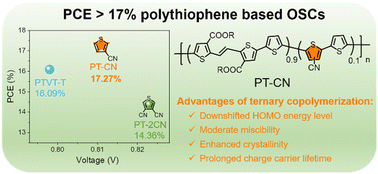Ternary polythiophene enables over 17% efficiency organic solar cells†
Abstract
Polythiophenes (PTs) are one of the most promising donor materials for organic solar cells (OSCs), because of their low-cost production. However, most PT-based OSCs suffer from inferior power conversion efficiencies (PCEs) currently, mainly due to the mismatched energy levels and hyper-miscibility of PTs with state-of-the-art fused ring electron acceptors (FREAs). On account of the issues, two ternary PT donors, PT-CN and PT-2CN, are developed by inserting the simple and strong electron-withdrawing units (3-cyanothiophene and 3,4-dicyanothiophene) into a low-cost PT, PTVT-T, via random copolymerization, respectively. Introducing the ternary unit not only deepens the highest occupied molecular orbital energy level and brings down the miscibility of PTs with FREAs, but also makes the crystallinity of the PTs first increase then decrease from PTVT-T, PT-CN to PT-2CN. Thus, the moderate miscibility and highest crystallinity of PT-CN endows the PT-CN:BTP-eC9 blend film with proper phase separation having orderly molecular stacking to achieve the most efficient exciton dissociation and lowest trap density. Such enables PT-CN:BTP-eC9 based devices to achieve the highest charge carrier mobilities and lifetime, suppressing charge carrier recombination and facilitating charge carrier extraction. Therefore, the PT-CN:BTP-eC9 based OSC affords a higher PCE of 17.27% than PTVT-T:BTP-eC9 and PT-2CN:BTP-eC9 based counterparts, which, to the best of our knowledge, is the highest value for PT-based OSCs so far. The results demonstrate that ternary copolymerization is a facile and efficient route to realize high-efficiency but low-cost PT donors.



 Please wait while we load your content...
Please wait while we load your content...